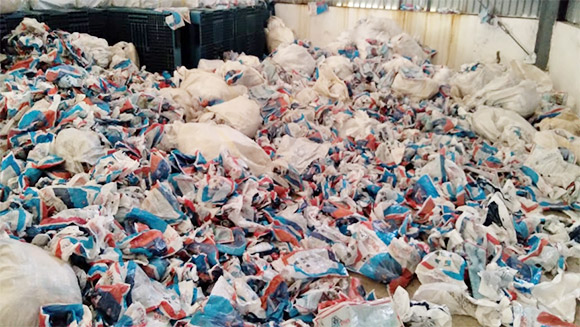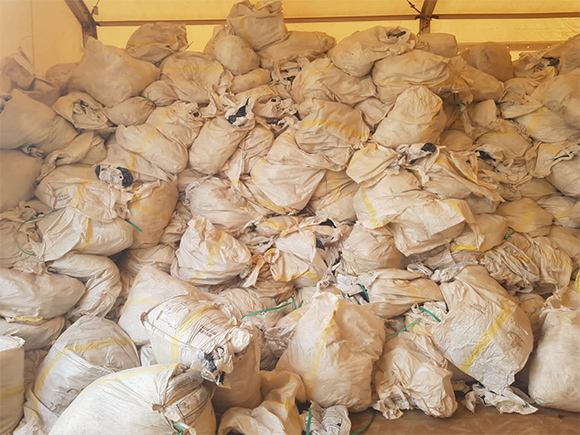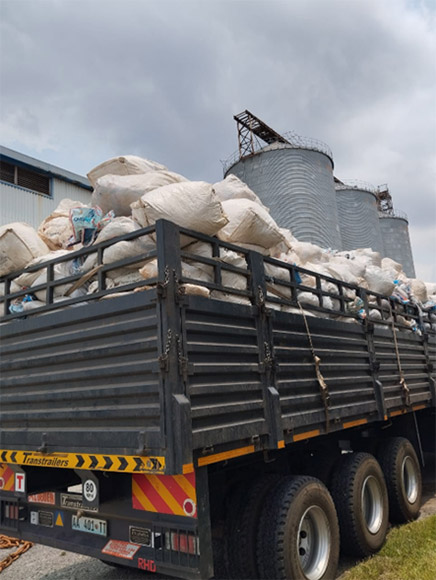
Waste generated in Namacurra district, Zambézia Province. Photo: Programa Nacional de Controlo da Malária/ Direcção Provincial de Saúde, Tete
For its 2023 ITN mass distribution campaign, the National Malaria Control Programme (NMCP) in Mozambique changed its strategy to distribute individually packaged ITNs, primarily in response to ITN and bale quality issues from the 2019/20 experience with bulk packaged nets. The 2023 campaign covered nine provinces targeting approximately 31 million people with 17,351,450 ITNs. A mix of different types of ITNs (PBOs and IG2®) were distributed through a door-to-door single phase distribution, i.e. registering households and distributing ITNs at the same time. During planning and procurement of the ITNs, the NMCP and its implementing partner, World Vision Mozambique (WVM), realized that the distribution of individually packaged ITNs would result in a large volume of plastic waste, i.e. the bags in which the nets are packed, as well as the baling material, that needed to be managed.
There are two main options when managing plastic waste from individually packed ITNs:
- Households manage the waste themselves, often by burning, burial or repurposing of the bag or
- Campaign personnel can manage the waste by collecting it at the point of distribution and storing it for disposal at the end of the campaign.

Waste storage at the district warehouse-Chifunde. Photo: Programa Nacional de Controlo da Malária/ Direcção Provincial de Saúde, Tete
Households often face challenges when managing waste themselves. Disposal practices can include open air burning or burial of the plastic bags, which can have detrimental environmental effects as burning releases toxins into the air, and burial might taint nearby water sources and the plastic will still not biodegrade or compost in the soil. Households often repurpose the plastic packaging into bags for carrying food and non-food items, which is not recommended since the bags are tainted with insecticide.
Planning and implementation of effective waste management by campaign personnel for the volume of plastic packaging generated by the ITN campaign has several considerations from the central to the operational level. Issues include ensuring that the plastic bags are collected and stored at decentralized levels while minimizing exposure of campaign workers to residual insecticide, transport of the waste from the operational level to a location that can appropriately incinerate or recycle it and tracking the waste to ensure its exit from the campaign supply chain. This all takes up valuable resources that, with current financial constraints, may not be readily available.
Weighing the pros and cons, the NMCP and WVM decided that waste from the campaign needed to be managed by campaign personnel as part of the campaign implementation and close out strategy, not by households. During planning, an extensive mapping of recycling companies that operated in the targeted provinces and districts was developed. This mapping included not only where companies were based, but also how they were recycling waste and what the final products from the recycling were. Information sessions were held with the identified recycling companies to better define how a partnership could be established.

Transport of waste in Zambézia Province. Photo: Programa Nacional de Controlo da Malária/ Direcção Provincial de Saúde, Tete
While there were small variations between recycling companies in the way that the plastic waste was transported to their facilities, in general the following process was agreed upon for the provinces of Sofala, Zambézia and Tete:
- During the door-to-door distribution, the distribution teams handed the ITNs to households without their individual plastic packages.
- The individual plastic packages were collected and packed in the empty bale sacks that were used to transport the ITNs from manufacturers down to the pre-positioning sites at community level.
- Vehicles that were being used for monitoring visits in the field were used to transport the bales of used plastic packages back to the pre-positioning sites each day.
- At the end of the distribution period, the bales of plastic packages and undistributed ITNs were collected from the pre-positioning sites and transported to the respective district warehouses by the same vehicles used during pre-positioning.
- The recycling companies (and in some instances another stakeholder/partner) were then responsible for collecting the waste from the district level warehouses and transporting it to the factories for recycling.
The recycling companies did not charge the NMCP or WVM for the plastic waste. They were able to recycle the plastic waste to become raw materials that are later sold to manufacturers of plastic buckets, slippers, gum boots, plastic shopping bags, etc. This not only reduced the immediate potential environmental hazards in local communities, but also contributed to the economy through local production of raw materials and commodities.
A key lesson learned is that the mapping of private recyclers should include both an assessment of the company’s adherence to national environmental guidelines, including for management of plastic waste, and an assessment of the final commodity being produced to ensure that it is not adding more plastic waste in communities (e.g. recycling packages into plastic bags).
